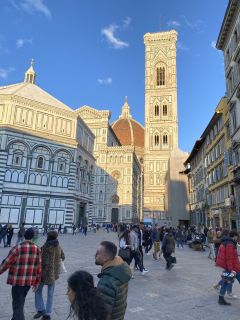

History Through Architecture
History through Architecture is a culminating course in the K-12 journey of Waldorf Education. It is a sweeping survey that traces the development of human consciousness over millennia from the earliest times to the present, including speculations about what the future may hold for our collective lives on Earth. Through this year’s special block, our 12th Graders explored their unique places in the long line of other human beings who have come before them. They began to see themselves with new eyes as they related to the larger human story.
The vehicle for their experience is what we call Architecture…a kind of “memory chip” that holds a rich tapestry of data points logged from all aspects of humanity – iconic facets that have imbued the “bricks-and-mortar” of buildings, cities, landscapes and human-made systems with the zeitgeist or spirit of the age in which they were manifested. Specific teachings in this block have been artfully designed to showcase how human ingenuity advanced with each succeeding generation. New ideas imaginatively evolved to produce structures, materials, energy and metaphysical awareness that created all our structures from simple barrow mounds of earliest human settlements to the soaring skyscrapers of our modern world. All of them imbued with an inner force – a seeking for higher awareness – what we term today a “spiritual experience”.
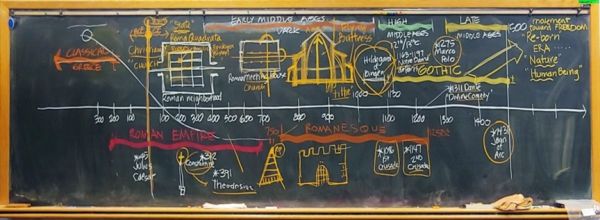
Colorful, hand-drawn chalkboards of chronological, step-by-step timelines showed how passive and dynamic forces of compression and tension moved across time to shape clay, stone, brick, metal, glass and myriad other materials and processes into the infinitely varied forms that we see in our material world. Concepts of “boundary” and “monument” drove the construction of fences, walls for protection from weather and wild animals, but also marked personal identity – whether for an individual or for tribes and clans, where the “I” became a “we”.
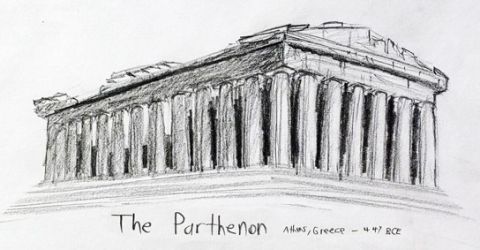 The students hand drew and wrote the salient points of the block into their Main Lesson books. Applying their innate Creativity and Imagination, they recorded the content of their learning. Some exercises were given to demonstrate how historic structures could be shown in plan, section and in three dimensions for learning how buildings are represented.
The students hand drew and wrote the salient points of the block into their Main Lesson books. Applying their innate Creativity and Imagination, they recorded the content of their learning. Some exercises were given to demonstrate how historic structures could be shown in plan, section and in three dimensions for learning how buildings are represented.
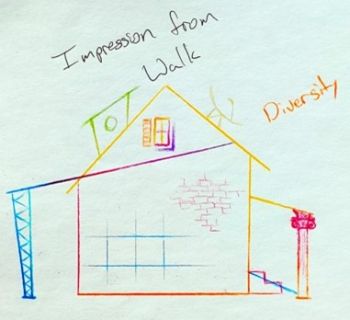 Other exercises engage the students’ personal observations and imaginations. For example, an “Impression/Expression” exercise was assigned for an outside walk taken through the Pontiac Trail neighborhood during one class period. Each student observed a particular perception along the way (a house, a tree, the rhythm of structures, a door or window detail, etc.) that impressed them. Returning to school, some form of expression was made from memory that described the nature of the student’s experience.
Other exercises engage the students’ personal observations and imaginations. For example, an “Impression/Expression” exercise was assigned for an outside walk taken through the Pontiac Trail neighborhood during one class period. Each student observed a particular perception along the way (a house, a tree, the rhythm of structures, a door or window detail, etc.) that impressed them. Returning to school, some form of expression was made from memory that described the nature of the student’s experience.
We contrasted challenging Thinking of the block’s first week with a Clay Handwork exercise that explored the curved line under the force of compression that freed the student’s imagination.
In the second week, Wooden Sticks Handwork created a new experience reflecting the advent of the straight-line forces of tension in history that led to developing open-structured trusses.
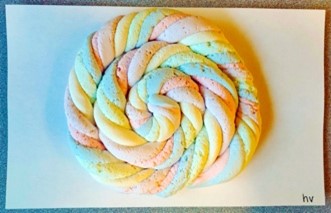
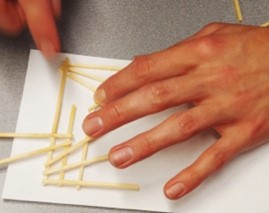
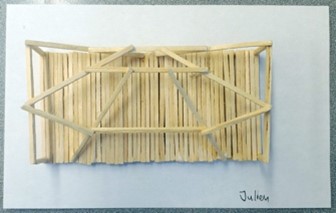
Toward the end of the block, after experiencing the great diversity of human structures built throughout history, students were given a final project where they were asked to design their own “architecture”. The day the assignment was given, this year’s Seniors immediately jumped into action, eagerly discussing possibilities and ideas for their individual or group to develop.
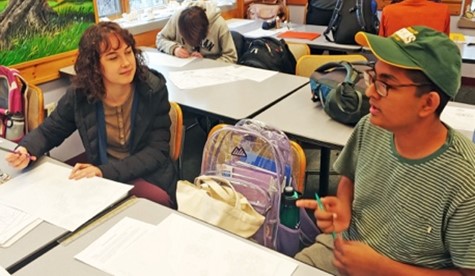 Over several days, students collaborated, talking and sketching ideas until a final design became clear. Every student prepared a statement, drawings, or a model to describe their vision. They then stood before their classmates and presented unique designs which inspired thoughtful questions and comments. This process of inner creativity - manifesting into outer forms -teaches lessons that will serve our Seniors as they venture out into the wider world to pursue their dreams in coming years.
Over several days, students collaborated, talking and sketching ideas until a final design became clear. Every student prepared a statement, drawings, or a model to describe their vision. They then stood before their classmates and presented unique designs which inspired thoughtful questions and comments. This process of inner creativity - manifesting into outer forms -teaches lessons that will serve our Seniors as they venture out into the wider world to pursue their dreams in coming years.
It is a great joy for me to witness the various revelations that unfold through each 12th Grader as they come to know themselves more deeply in the History through Architecture block.
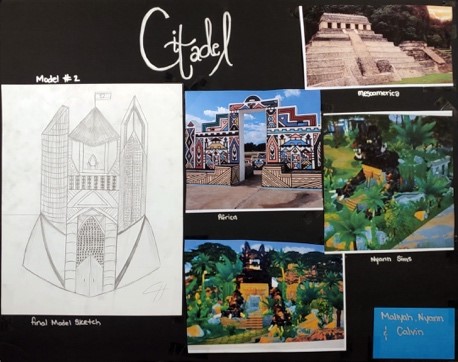
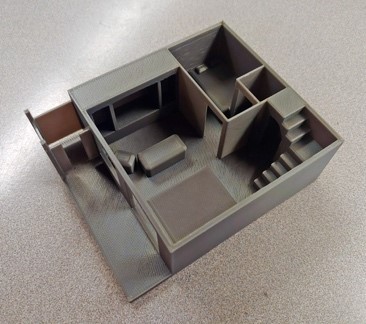
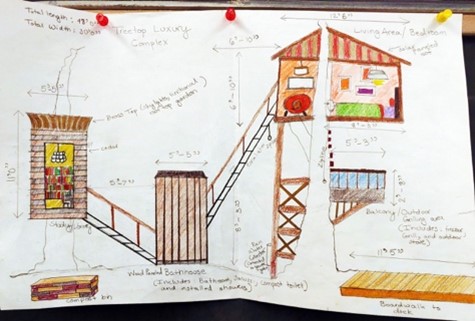
Research Supports the Benefits of Arts Education
Research shows that students who engage in the arts at school perform better in math, reading, and writing, and have an enhanced social and emotional experience. Waldorf education integrates an array of arts into the curriculum to support academic growth, develop communication and collaboration skills, and give children a well-rounded, joyful educational journey!
This article was originally written by Brian Kisida and Daniel H. Bowen and published by the Brookings Institution
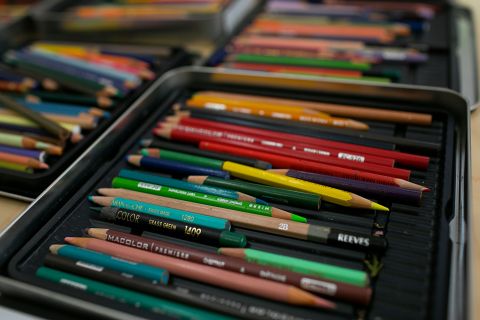
A critical challenge for arts education has been a lack of empirical evidence that demonstrates its educational value. Though few would deny that the arts confer intrinsic benefits, advocating “art for art’s sake” has been insufficient for preserving the arts in schools—despite national surveys showing an overwhelming majority of the public agrees that the arts are a necessary part of a well-rounded education.
Over the last few decades, the proportion of students receiving arts education has shrunk drastically. This trend is primarily attributable to the expansion of standardized-test-based accountability, which has pressured schools to focus resources on tested subjects. As the saying goes, what gets measured gets done. These pressures have disproportionately affected access to the arts in a negative way for students from historically underserved communities. For example, a federal government report found that schools designated under No Child Left Behind as needing improvement and schools with higher percentages of minority students were more likely to experience decreases in time spent on arts education.
We recently conducted the first ever large-scale, randomized controlled trial study of a city’s collective efforts to restore arts education through community partnerships and investments. Building on our previous investigations of the impacts of enriching arts field trip experiences, this study examines the effects of a sustained reinvigoration of schoolwide arts education. Specifically, our study focuses on the initial two years of Houston’s Arts Access Initiative and includes 42 elementary and middle schools with over 10,000 third- through eighth-grade students. Our study was made possible by generous support of the Houston Endowment, the National Endowment for the Arts, and the Spencer Foundation.
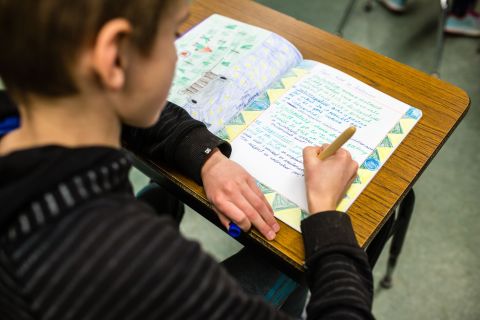
Due to the program’s gradual rollout and oversubscription, we implemented a lottery to randomly assign which schools initially participated. Half of these schools received substantial influxes of funding earmarked to provide students with a vast array of arts educational experiences throughout the school year. Participating schools were required to commit a monetary match to provide arts experiences. Including matched funds from the Houston Endowment, schools in the treatment group had an average of $14.67 annually per student to facilitate and enhance partnerships with arts organizations and institutions. In addition to arts education professional development for school leaders and teachers, students at the 21 treatment schools received, on average, 10 enriching arts educational experiences across dance, music, theater, and visual arts disciplines. Schools partnered with cultural organizations and institutions that provided these arts learning opportunities through before- and after-school programs, field trips, in-school performances from professional artists, and teaching-artist residencies. Principals worked with the Arts Access Initiative director and staff to help guide arts program selections that aligned with their schools’ goals.
Our research efforts were part of a multisector collaboration that united district administrators, cultural organizations and institutions, philanthropists, government officials, and researchers. Collective efforts similar to Houston’s Arts Access Initiative have become increasingly common means for supplementing arts education opportunities through school-community partnerships. Other examples include Boston’s Arts Expansion Initiative, Chicago’s Creative Schools Initiative, and Seattle’s Creative Advantage.
Through our partnership with the Houston Education Research Consortium, we obtained access to student-level demographics, attendance and disciplinary records, and test score achievement, as well as the ability to collect original survey data from all 42 schools on students’ school engagement and social and emotional-related outcomes.
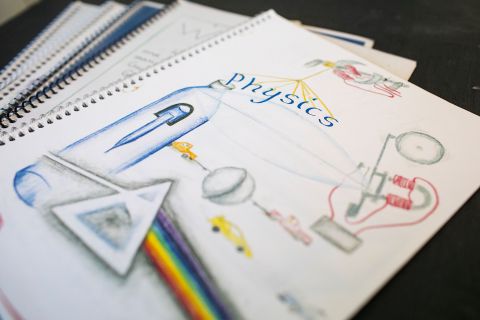
We find that a substantial increase in arts educational experiences has remarkable impacts on students’ academic, social, and emotional outcomes. Relative to students assigned to the control group, treatment school students experienced a 3.6 percentage point reduction in disciplinary infractions, an improvement of 13 percent of a standard deviation in standardized writing scores, and an increase of 8 percent of a standard deviation in their compassion for others. In terms of our measure of compassion for others, students who received more arts education experiences are more interested in how other people feel and more likely to want to help people who are treated badly.
When we restrict our analysis to elementary schools, which comprised 86 percent of the sample and were the primary target of the program, we also find that increases in arts learning positively and significantly affect students’ school engagement, college aspirations, and their inclinations to draw upon works of art as a means for empathizing with others. In terms of school engagement, students in the treatment group were more likely to agree that school work is enjoyable, makes them think about things in new ways, and that their school offers programs, classes, and activities that keep them interested in school. We generally did not find evidence to suggest significant impacts on students’ math, reading, or science achievement, attendance, or our other survey outcomes, which we discuss in our full report.
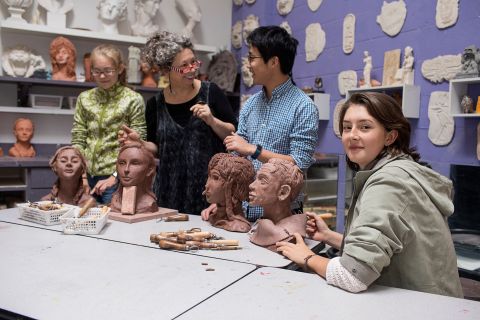
As education policymakers increasingly rely on empirical evidence to guide and justify decisions, advocates struggle to make the case for the preservation and restoration of K-12 arts education. To date, there is a remarkable lack of large-scale experimental studies that investigate the educational impacts of the arts. One problem is that U.S. school systems rarely collect and report basic data that researchers could use to assess students’ access and participation in arts educational programs. Moreover, the most promising outcomes associated with arts education learning objectives extend beyond commonly reported outcomes such as math and reading test scores. There are strong reasons to suspect that engagement in arts education can improve school climate, empower students with a sense of purpose and ownership, and enhance mutual respect for their teachers and peers. Yet, as educators and policymakers have come to recognize the importance of expanding the measures we use to assess educational effectiveness, data measuring social and emotional benefits are not widely collected. Future efforts should continue to expand on the types of measures used to assess educational program and policy effectiveness.
These findings provide strong evidence that arts educational experiences can produce significant positive impacts on academic and social development. Because schools play a pivotal role in cultivating the next generation of citizens and leaders, it is imperative that we reflect on the fundamental purpose of a well-rounded education. This mission is critical in a time of heightened intolerance and pressing threats to our core democratic values. As policymakers begin to collect and value outcome measures beyond test scores, we are likely to further recognize the value of the arts in the fundamental mission of education.
A Beautiful Experiment (Italy Part 2)
A beautiful experiment: 17 high school seniors, 5 teachers, and Venice, the floating city. Ms. Efimova, our high school art teacher, had the original idea, an “art trip…with sketchbooks.” After nearly a year of preparation, our plane left Detroit Metro Airport for Venice. It was March, 2001. Twenty trips later, the Italian Journey has become a cherished tradition for the seniors at Rudolf Steiner High School. Spring arrives in Italy, and our Italian friends wait impatiently for us to arrive. They deeply appreciate our students’ joyful laughter, heartfelt curiosity about Italy, thoughtfulness, kindness, singing, and gorgeous drawings. One of our guides has said, “No one on earth travels like this school”. It is true. We are not tourists at all, but thinkers and artists open to the possibility of surprising transformations. In a way, the experiment continues, with amazing results year after year.
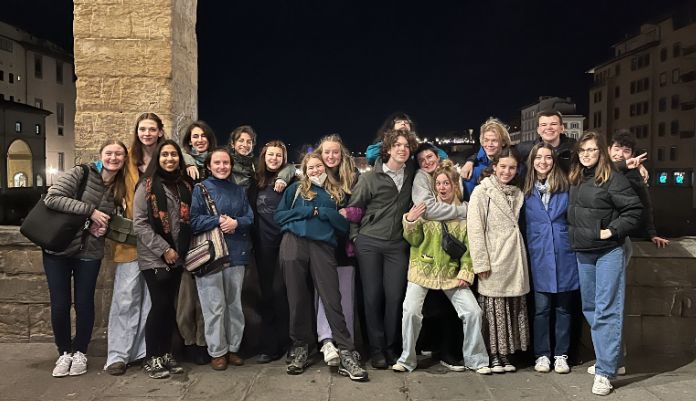
No one on earth travels like this school.
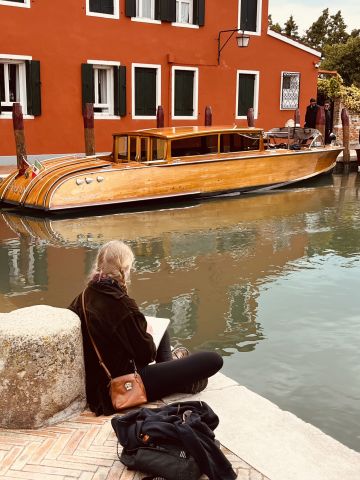 Venice, Florence, and Rome are our three muses now, with, when possible, the sweet addition of Orvieto, Lucca, Fiesole, Verona, or Vatican City. We begin in Venice. It is impossible to imagine this most improbable of cities until we sit in the rocking boat which takes us to the main islands of Venice. Arriving by sea has been the custom for about 1500 years. We disembark and the students gasp. “It is unreal!” “The buildings are older than a forest!” “There are no cars, and I hear just the water!” “It is a dream.” The changing colors and the continual movement of the water are mesmerizing, “quasi una fantasia”, almost like a fantasy. That’s the tempo marking for Beethoven’s “Moonlight Sonata”. If you cannot fly to Venice right this moment, try listening to that well-known piece. It will comfort you! This is the city married to the sea, but also the city where Galileo demonstrated his telescope for the Doge from the top of the bell tower. Optics and acoustics. A Scientific Revolution on the way.
Venice, Florence, and Rome are our three muses now, with, when possible, the sweet addition of Orvieto, Lucca, Fiesole, Verona, or Vatican City. We begin in Venice. It is impossible to imagine this most improbable of cities until we sit in the rocking boat which takes us to the main islands of Venice. Arriving by sea has been the custom for about 1500 years. We disembark and the students gasp. “It is unreal!” “The buildings are older than a forest!” “There are no cars, and I hear just the water!” “It is a dream.” The changing colors and the continual movement of the water are mesmerizing, “quasi una fantasia”, almost like a fantasy. That’s the tempo marking for Beethoven’s “Moonlight Sonata”. If you cannot fly to Venice right this moment, try listening to that well-known piece. It will comfort you! This is the city married to the sea, but also the city where Galileo demonstrated his telescope for the Doge from the top of the bell tower. Optics and acoustics. A Scientific Revolution on the way.
Quasi una fantasia.
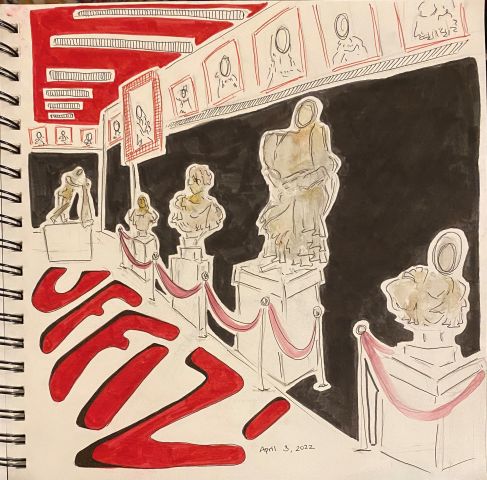 Water gives way to solid ground. We arrive in Florence, a city of prose and poetry, individualism and competition, science and art, dark buildings and sun-drenched courtyards. An Italian proverb states that spring has arrived “when you can step on nine daisies at once.” At the convent that has been our home in Florence these many years, we are greeted by both the nuns, and the garden daisies. Within moments, our students are weaving garlands for their hair. Then to sketch Michelangelo’s “David”! We walk in his footsteps, and Dante’s, and Brunelleschi’s, and Leonardo’s and again, Galileo’s. Academic lessons happens in tiny bursts. Here is the corner where Michelangelo and Leonardo argued, there is Dante’s street, that’s where Botticelli burned his paintings (fortunately not all of them). The intrigue, the excitement, the stupendous discoveries of Renaissance Florentines continue to resound. The cast of characters has changed, but the stage sets are all still there.
Water gives way to solid ground. We arrive in Florence, a city of prose and poetry, individualism and competition, science and art, dark buildings and sun-drenched courtyards. An Italian proverb states that spring has arrived “when you can step on nine daisies at once.” At the convent that has been our home in Florence these many years, we are greeted by both the nuns, and the garden daisies. Within moments, our students are weaving garlands for their hair. Then to sketch Michelangelo’s “David”! We walk in his footsteps, and Dante’s, and Brunelleschi’s, and Leonardo’s and again, Galileo’s. Academic lessons happens in tiny bursts. Here is the corner where Michelangelo and Leonardo argued, there is Dante’s street, that’s where Botticelli burned his paintings (fortunately not all of them). The intrigue, the excitement, the stupendous discoveries of Renaissance Florentines continue to resound. The cast of characters has changed, but the stage sets are all still there.
Grand Finale! Urbs Aeterna: The Eternal City. Rome! The scale is immense. The architecture, in ruins or intact, is magnificent, the vistas are glorious. Mosaic, paint, marble, bronze, gold, and ancient, perfect, concrete compete for our attention. Archeological work is everywhere. After all, 80% of Rome is still buried underground, and someone must dig it up! This city is modern and ancient and medieval and Renaissance and Baroque all at once. How can we make sense of it? Our beloved guide weaves a tapestry of stories while we walk together. She does it so wonderfully that sometimes we cry. Her stories are timed to our steps through the streets. It is her unique form of choreography. Genius, truly. We are enriched and at home. She has given us the keys to the city.
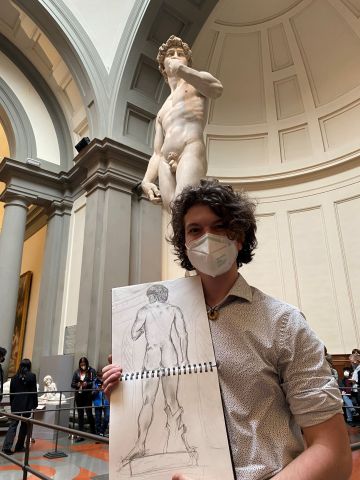 Our Italian Journey comes to a close for another year. Almost 450 students and teachers have traveled to Italy with Rudolf Steiner High School. Every single one has left an imprint. All have strong memories, sketchbooks and a connection with the world and each other that cannot be created in the classroom alone. We're honored to be able to offer this unique experience to our students and grateful to all who have been a part of it. Grazie Mille! Deepest thanks to all who have made this beautiful idea an even more beautiful reality!
Our Italian Journey comes to a close for another year. Almost 450 students and teachers have traveled to Italy with Rudolf Steiner High School. Every single one has left an imprint. All have strong memories, sketchbooks and a connection with the world and each other that cannot be created in the classroom alone. We're honored to be able to offer this unique experience to our students and grateful to all who have been a part of it. Grazie Mille! Deepest thanks to all who have made this beautiful idea an even more beautiful reality!
(We'd like to express our regret to the classes of 2020 and 2021 who, due to the pandemic, were unable to experience Italy in this way.)
Please Enjoy Our YouTube Video
Our Return to Italy (Part 1)
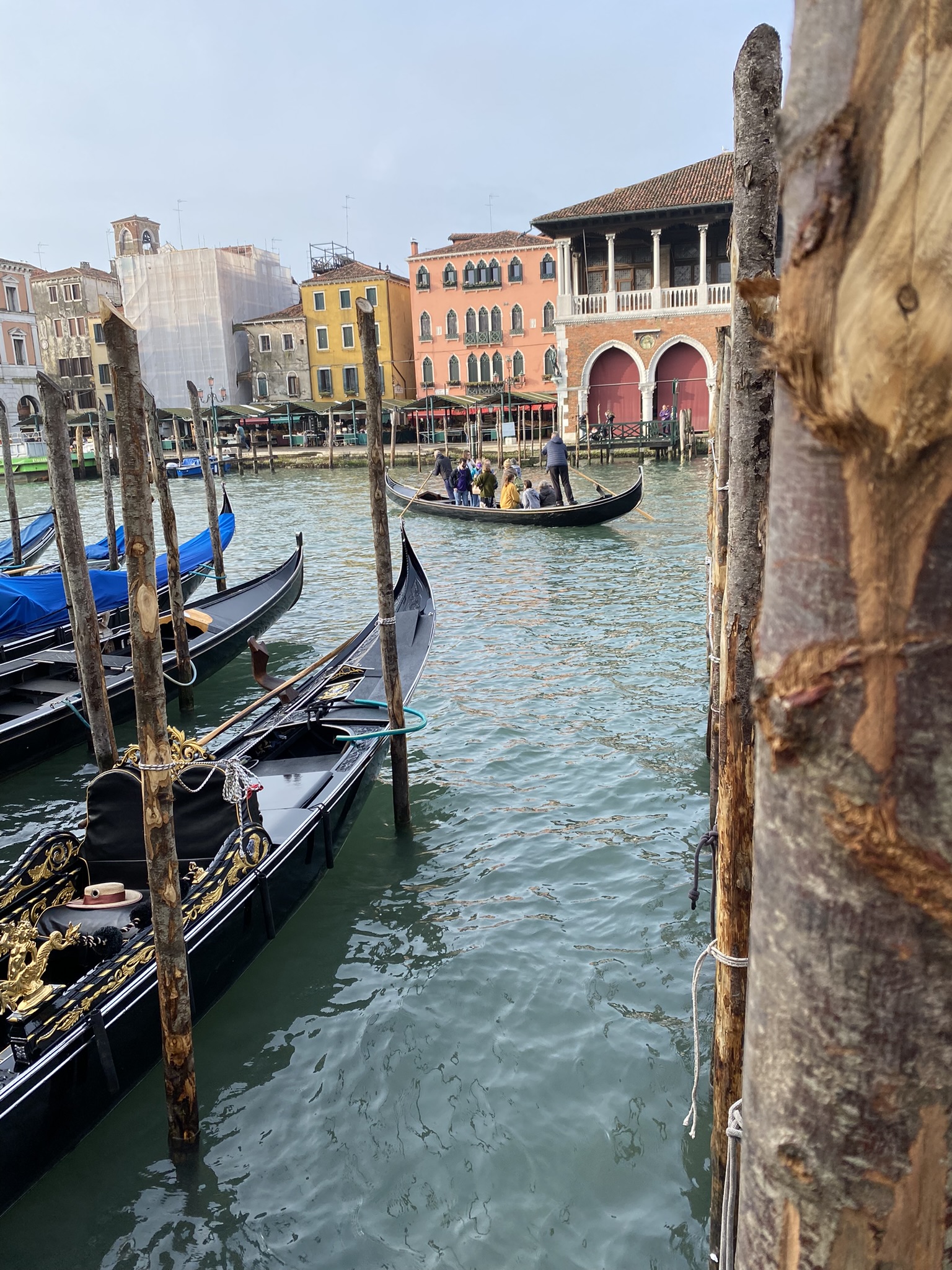
Despite the trepidation we all felt in planning for this trip during the ongoing pandemic, after two years without it we felt more sure than ever about the value of this capstone experience to our senior students, and we charged ahead. It took many months to plan and we had multiple scares with the vagaries of the flight and tour schedules, the worry over possible loss of accommodations due to COVID, and the additional work of verifying and collecting vaccination information and ongoing COVID testing for all students and chaperones, but everything fell into place. Before departing, students had a week and a half of intense preparation where they learned in-depth history and the curriculum context of the places they would visit, as well as some Italian phrases. They also had some time to practice live sketching. The careful planning of the trip - both curricularly and logistically - paved the way for a smooth and enriching experience for all the students.
The trip was seven nights: three in Venice, two in Florence, and two in Rome. Students visited important art and historical sites and were required to capture their trip via drawings and written reflections in their sketchbooks.
Upon their return, each student highlighted a meaningful Italy moment during an all-school assembly, including:
- Being outside of the USA for the first time and experiencing all the differences and surprises
- Going on group night walks in Venice and seeing the difference between the busy day time and serene night time
- Experiencing St. Peters Basilica at the Vatican
- Seeing everything we learned in Art History class up close
- The many androgynous-looking statues beautifully displayed in The Uffizi
- Climbing up the Campanile (belltower) in Florence and seeing how beautiful the city looks
- Walking in the footsteps of the many great artists we learned about in school
- Seeing Botticelli’s The Birth of Venus in real life
- Touring the Roman Forum with our guide, Francesca, and reliving ancient Rome
- The restaurants, convents, and hotels where our school has long standing relationships
We are thrilled that the students were able to have these experiences after the disappointment of the canceled trips in 2020 and 2021. The Italy trip, like all of our school trips, is an opportunity for growth unlike what most students have in their day-to-day classes and extracurricular activities. Our class of 2022 students jumped at the chance to experience another culture, to see different ways of conducting daily life, and to consider a different, and much longer, sense of time through the history around them. Our wish is that they continue to lean in to the curiosity they have developed in high school so that they can keep learning and growing.
Join us for an in-depth look at the trip itself in our next Look A Little Deeper blog post!
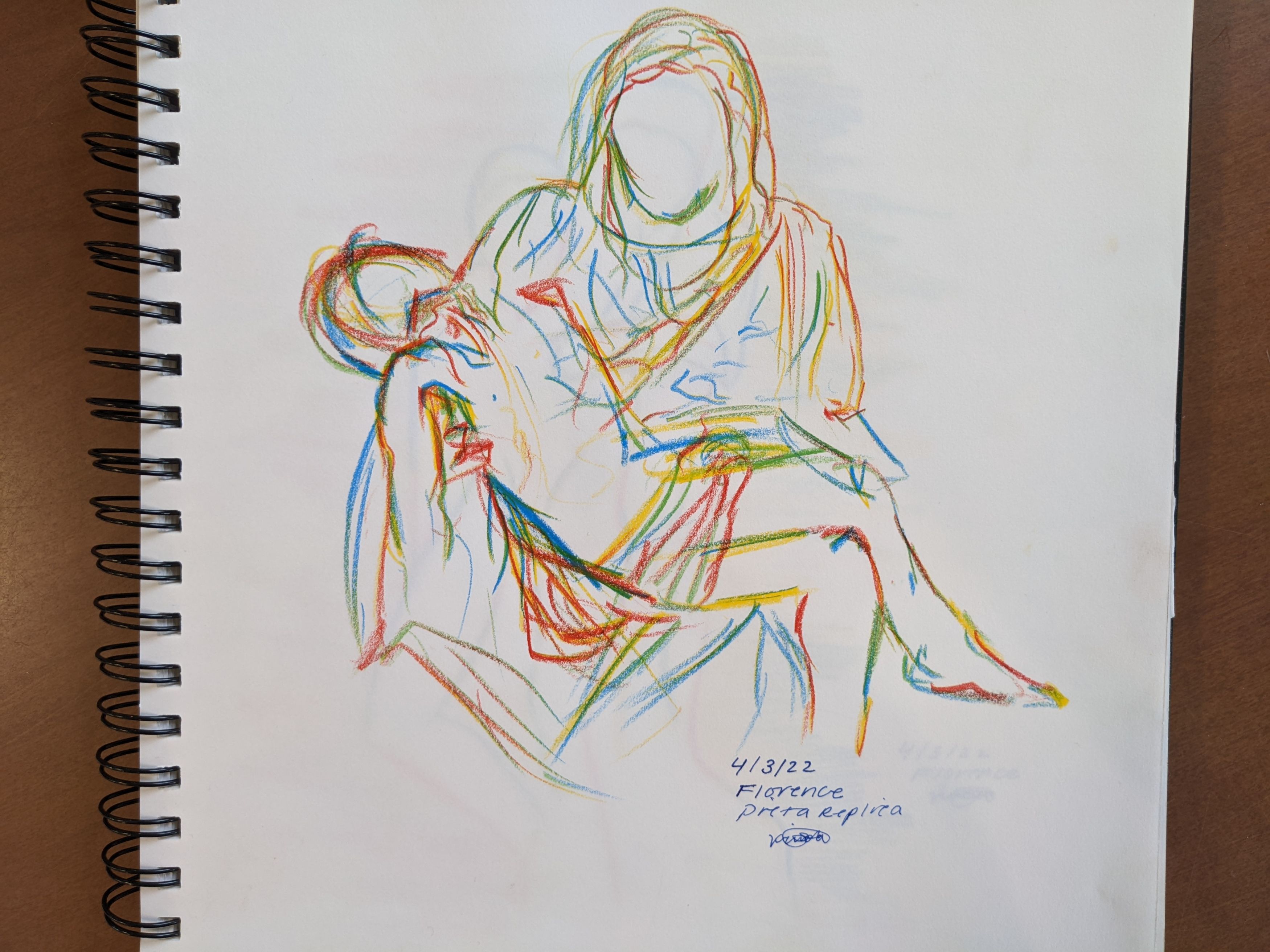
More Than a Body: Capturing the Essence of Another Human
When Elizaveta McFall (HS Art faculty, parent & HS Alum ‘04) began teaching the HS figure-drawing class over four years ago, she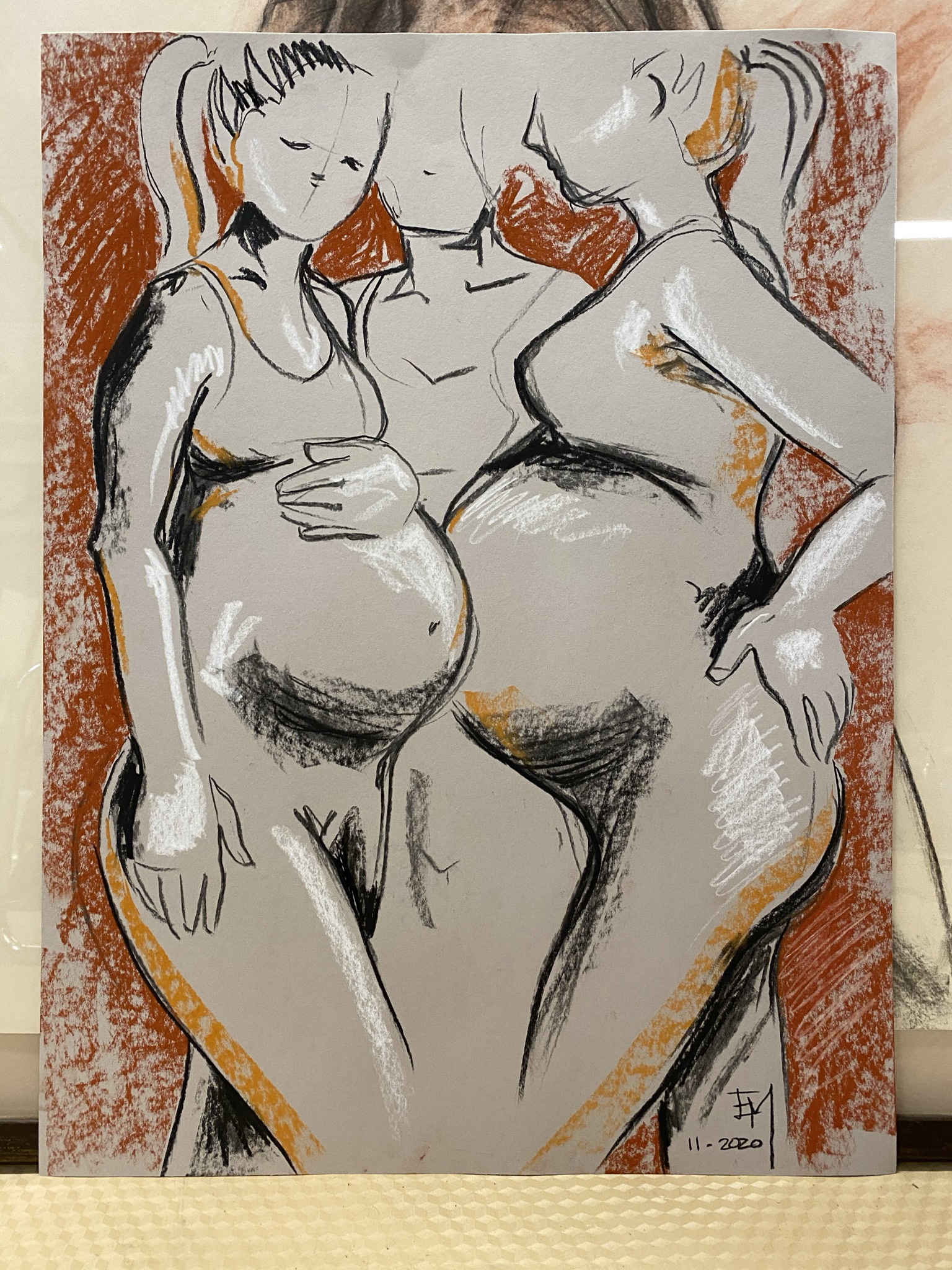
Elizaveta saw an opportunity to re-imagine the approach to this tradition by establishing a dialogue and relationship with the models themselves. She wanted her students to fall in love with people and to see them as art. From her perspective, it is easy to learn the proportions of the human body, but the real work is to capture the model as they are.
She wanted her students to fall in love with people and to see them as art.
In the past, only one model would visit the classroom over a period of several weeks. Now there was an opportunity to open that experience up by inviting multiple models to pose on different days, giving the students a chance to see a variety of human bodies. Her models have evolved from “accepted” male and female body-types to now include a variety of bodies, sizes, gender, and age. This year, she invited a professional wheelchair basketball player who entered the class on his prosthetic legs, talked with the class, then removed his legs and posed for the students in his athletic wheelchair.
Elizaveta wanted to integrate social-emotional learning into the students experience by establishing a relationship with the models during their session. She creates an environment for the models and students to have a conversation. Before the model visits, the students talk about how the model might feel when they arrive - vulnerable, uncomfortable, or nervous. She asks students how do we make them comfortable? Should we giggle (even if it’s not about the model)? Should we ask questions and what kinds of questions? She prepares them to think about “nude” as a genre in art and to look at the model as nude - not naked. Students work through how those terms make them feel.
Before the model visits, the students talk about how the model might feel when they arrive - vulnerable, uncomfortable, or nervous.
Through earlier conversations with the models, Elizaveta learns about their lives, hobbies, jobs or interests. She asks them to think about the shape of their bodies and learns what they are comfortable talking about. This information is then integrated into her class, so she can model the conversation for students, who then begin to pick-up on her approach.
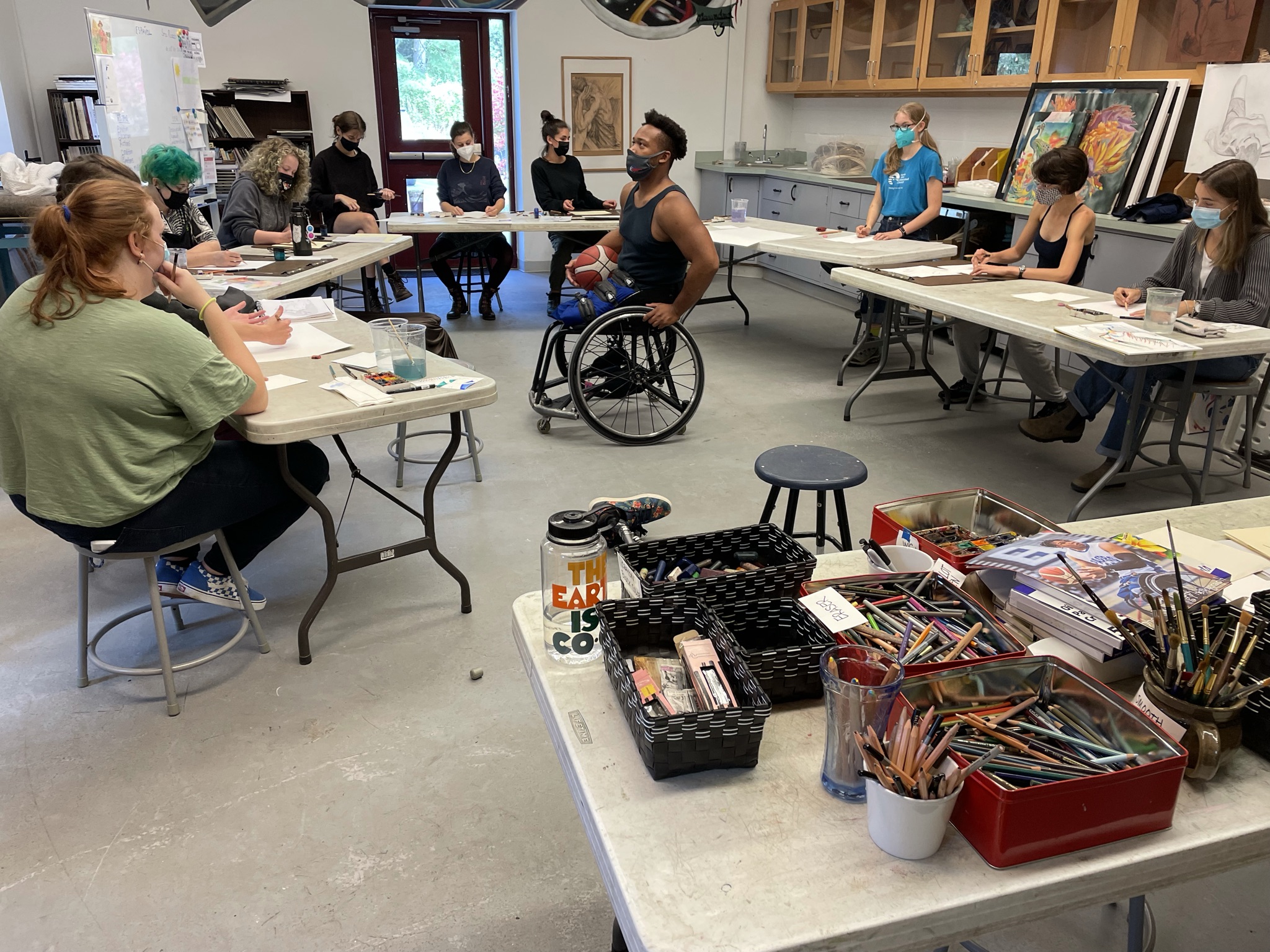
Once the model is back in the room, a comfortable rapport builds as Elizaveta demonstrates for students the questions to ask the models. Nikki, a plus-sized model, is asked about her journey of loving her curvy body. Elizaveta asks the students, “Does Nikki want large paper or small? Do we use straight lines or curved? Where is she most narrow or where is she most broad? What ways can we capture Nikki’s curves?”. It becomes clear that their bodies are aspects of who they are. A trans male model is not introduced by this title but through Elizaveta’s questions, they reveal a favorite part of their transformed body. The conversation with Zeus, a professional wheelchair athlete, reveals how he functions in the sport and how he uses his prosthetics to walk. A pregnant model talks about the temporary body she wears, where she gained weight and the purpose of those changes for the baby.
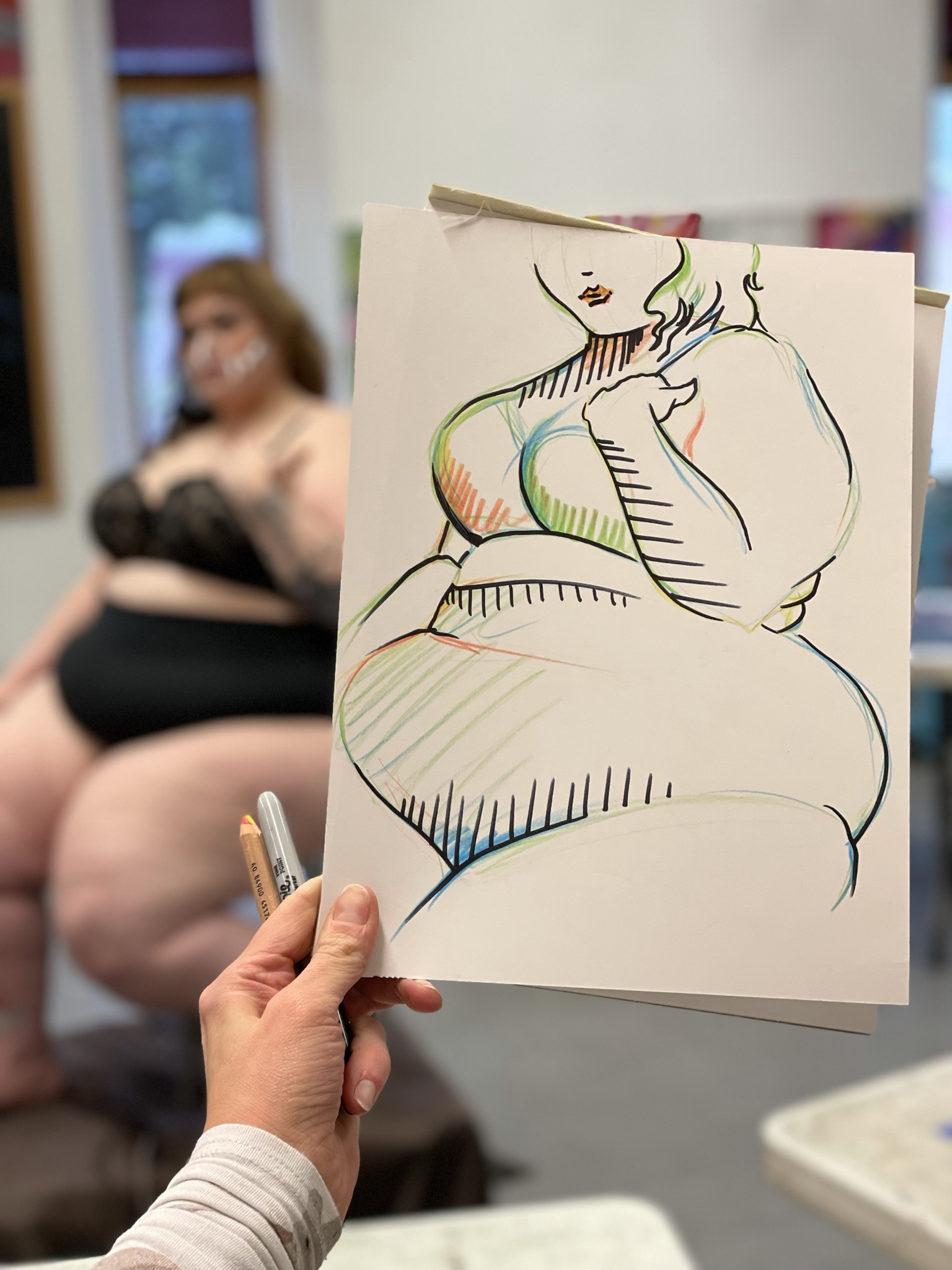
For students, seeing a body like their own or talking with a trans person or someone with a disability who have fully fallen in love with themselves can be a very powerful experience. Student interests are diverse - from the hard sciences, computers, history, or fine arts - but every high school senior participates in the figure drawing class and is given the opportunity to appreciate the beauty in the diversity of human bodies and interact with the amazing people who inhabit them. Elizaveta knew this new approach would be a unique experience, and the greater impact it would have on our students social-emotional skills and opportunities for growth beyond artistic abilities.
For students, seeing a body like their own or talking with a trans person or someone with a disability who have fully fallen in love with themselves can be a very powerful experience.

